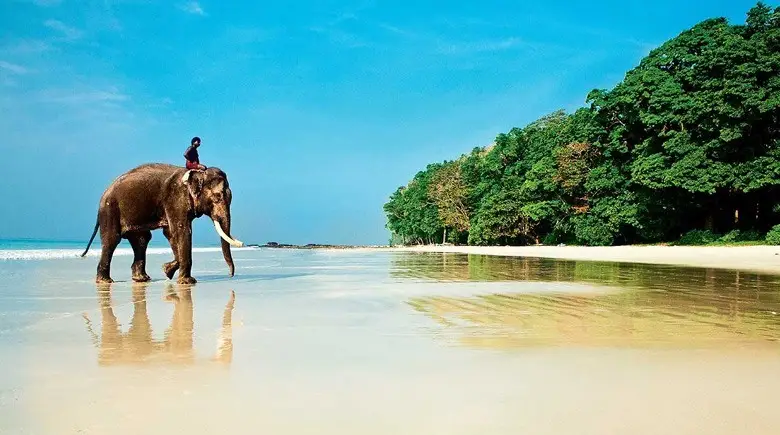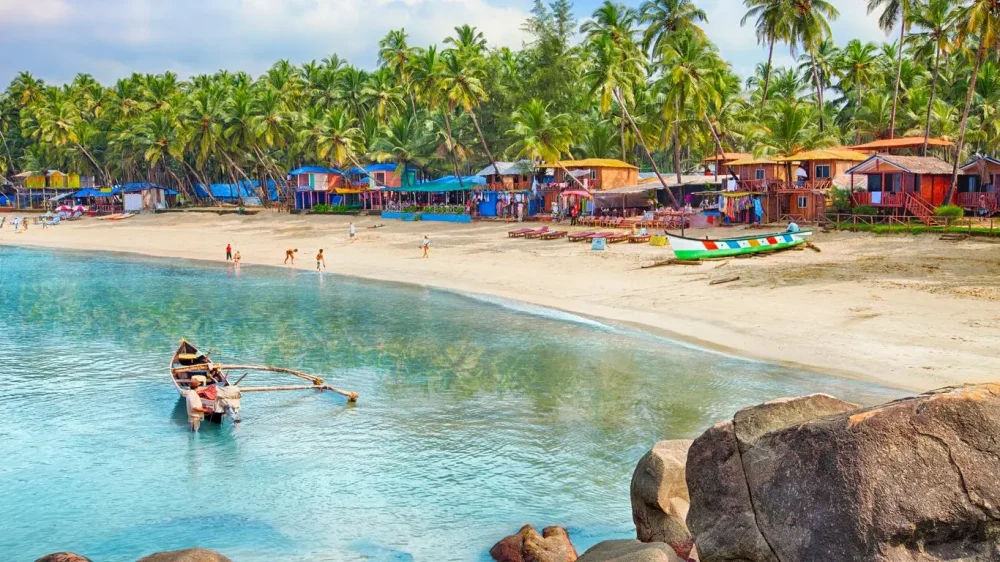A country where natural diversity is truly astonishing. Here you can see snow-capped peaks of the Himalayas, lush jungles, exotic islands, and vast sandy deserts. The most beautiful places in India are not only popular attractions but also corners where the true magnificence of nature unfolds.
The amazing natural attractions of India leave an indelible impression. In this article, we will talk about locations that are worth seeing at least once in a lifetime.

One of the most breathtaking waterfalls in India is Dudhsagar. The name translates to “Sea of Milk,” and not without reason – the water streams truly resemble flows of spilled milk, cascading from a height of over 300 meters.
The waterfall is located in the Bhagwan Mahavir Wildlife Sanctuary in Goa. It can only be reached by off-road vehicles, making the journey even more exhilarating. During the monsoon season, when Dudhsagar is particularly powerful, the spectacle becomes truly grandiose.
One of the most magical places in the country. The national park is a unique natural area in the state of Uttarakhand, which turns into a sea of flowers during the blooming season.
In summer, hundreds of rare plant species bloom here: orchids, blue poppies, lilies, and many others. The location is so unusual that it is included in the UNESCO World Heritage List.
Tourists have to walk several kilometers on mountain trails before they find themselves in this fairy-tale corner. However, the efforts are worth it: the landscape that unfolds before your eyes amazes with its brightness and harmony.
When it comes to natural beauty, one cannot overlook Dal Lake, located in picturesque Kashmir. The place is famous for its floating markets and traditional shikara boats leisurely gliding on the mirror-like water surface.
The lake looks especially magical at sunrise when the sun paints it in golden hues, and the mountains are reflected in the water, creating a fantastic landscape. Tourists can rent a houseboat and embark on a journey in a real floating palace, enjoying the unique atmosphere of the location.
Indian tea is not just a beverage but a true culture, and it is best to explore it where it is grown. The tea plantations in Darjeeling are one of the most beautiful places in India. They are endless green hills covered with aromatic bushes, among which small factories and traditional villages are scattered.
Here you can not only enjoy delightful landscapes but also see how tea leaves are harvested, taste freshly brewed tea, and even take part in a tea ceremony.
One of the largest and most beautiful lagoons in Asia is Chilika, located in the state of Odisha. A unique location that is home to a multitude of migratory birds, rare fish species, and even Irrawaddy dolphins.
Tourists can take a boat ride to see rare marine inhabitants and enjoy secluded spots of picturesque nature during their journey. The lagoon is especially beautiful during the bird migration season when thousands of flamingos, herons, and other feathered travelers arrive here.
When it comes to the most beautiful places for relaxation in India, one cannot forget about Havelock Island, considered one of the main gems of the Andaman Islands. It boasts some of the best beaches with white sand and crystal clear water.
The island is perfect for diving and snorkeling, as the underwater world of the Andamans is incredibly rich: you can see bright fish, corals, and even sea turtles.
When talking about the natural attractions of India, it is impossible not to mention the Ganges River. It looks particularly majestic at sunrise in the city of Varanasi when the first rays of the sun illuminate the waters, and people perform traditional rituals.
The water body is full of energy and ancient traditions that can be felt literally at every step.
When traveling to the most beautiful places in India, it is important to consider the rules of visiting that will help preserve the country’s unique nature. Let’s take a closer look:
Following these recommendations will not only make your journey comfortable but also help preserve the Indian nature in its pristine form.

The most beautiful places in India are not just architectural landmarks but also stunning natural spots that take your breath away. Here you can see majestic waterfalls, vast lakes, sacred rivers, exotic islands, serene tea plantations, and mysterious lagoons.
Embarking on a journey through the country, you will discover the true beauty of Indian nature, visit locations that fill you with energy and provide unforgettable experiences!

India’s tourist geography encompasses coastal zones, mountain ranges, cultural valleys, desert oases and forest plateaus. India’s resorts are not limited to beaches alone. They form a mosaic picture where each region reveals its own climate, rhythm and holiday rituals. Ayurvedic practices, ocean walks, meditation retreats and trekking routes in the Himalayas are equally in demand …

Travelling to the district reveals to tourists a completely different face of India – tranquil, peaceful and immersed in nature. It hides pristine beaches, ancient temples, ayurvedic centres and protected corners where time seems to slow down. Holidays in South Goa are the choice of those who are looking for something interesting and unusual to …